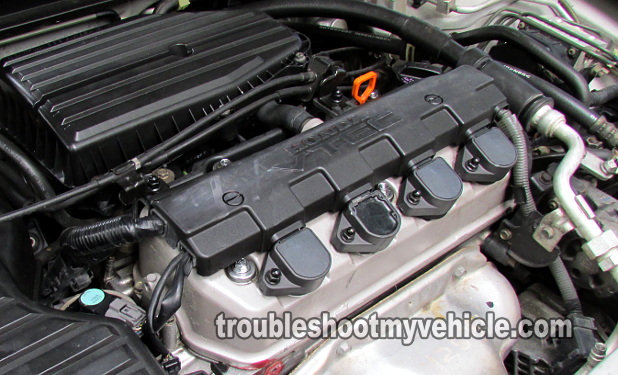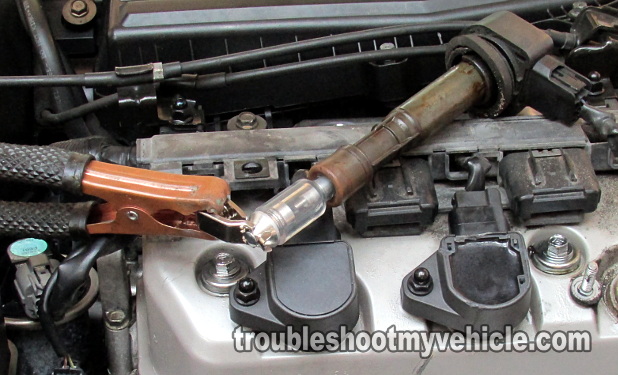
In this tutorial, I'm gonna' show you just how easy it is to test the ignition coils on your 1.7L Honda and find out if one of them is bad or not. These ignition coils are known technically as Coil-On-Plug (COP) ignition coils.
If you suspect that your Honda has a bad COP ignition coil that's causing a misfire condition (and setting a misfire code that is lighting the check engine light (CEL)), then this is the tutorial you need.
Contents of this tutorial:
- Symptoms Of A Bad COP Ignition Coil.
- What Tools Do I Need To Test The COP Coils?
- TEST 1: Checking For Misfire Codes.
- TEST 2: Check The Ignition Coil For Spark.
- TEST 3: Swap The 'No Spark' COP Coil.
- Spark Plug Tube Seals Leaking Engine Oil.
- Where To Buy The COP Ignition Coils.
- More 1.7L Honda Civic Tutorials.
APPLIES TO: This Coil-On-Plug (COP) ignition coil circuit wiring diagram applies to the following vehicles:
- 1.7L Honda Civic DX: 2001, 2002, 2003, 2004, 2005.
- 1.7L Honda Civic EX: 2001, 2002, 2003, 2004, 2005.
- 1.7L Honda Civic GX: 2001, 2002, 2003, 2004, 2005.
- 1.7L Honda Civic HX: 2001, 2002, 2003, 2004, 2005.
- 1.7L Honda Civic LX: 2001, 2002, 2003, 2004, 2005.
ES ![]() You can find this tutorial in Spanish here: Cómo Verificar Las Bobinas De Encendido (2001-2005 1.7L Honda) (at: autotecnico-online.com).
You can find this tutorial in Spanish here: Cómo Verificar Las Bobinas De Encendido (2001-2005 1.7L Honda) (at: autotecnico-online.com).
WIRING DIAGRAM: Ignition Coil Wiring Diagram (2001-2005 1.7L Honda Civic).
Symptoms Of A Bad COP Ignition Coil
In a nutshell, each of the four cylinders of your Honda Civic's 1.7L engine needs air (compression), fuel, and spark to produce power.
The ignition coils, that sit on top of the valve cover, are the ones tasked with creating and delivering spark and when one or several fail, you'll have a bonafide misfire that will affect the way your Civic idles and accelerates.
Your 1.7L Honda will also show one or more of the following symptoms:
- Diagnostic trouble codes (DTCs) lighting up the check engine light (CEL):
- P0300: Random Cylinder Misfire.
- P0301: Cylinder #1 Misfire.
- P0302: Cylinder #2 Misfire.
- P0303: Cylinder #3 Misfire.
- P0304: Cylinder #4 Misfire.
- Rough idle.
- Smell of raw gasoline coming out of the tailpipe.
- Bad gas mileage.
- Won't pass the emissions test (smog test).
- Extended cranking time (hard start).
- If more than one ignition coil is bad, your Honda won't start.
If your Honda is experiencing any of the above symptoms, chances are that you do have a bad COP coil on your hands. Let's take a look at some of the basic tools you'll need to diagnose and repair this yourself.
What Tools Do I Need To Test The COP Coils?
You don't need any expensive or exotic diagnostic tools to diagnose a bad ignition coil on your 2001-2005 1.7L Honda Civic.
The most important tool that you're gonna' need, to test the ignition coils for spark, is a spark tester.
I'm gonna' recommend one that is the most effective (and the most inexpensive) out there: the HEI spark tester (OTC 6589).
From personal experience (I work full-time as an automotive tech) I can tell you that the HEI spark tester is a must-have tool. You don't need to interpret the color of the spark or the weakness of it. With the HEI spark tester, if it sparks then the ignition coil is good.
- A spark tester.
- Any spark tester will do. The one I use and recommend is the OTC HEI spark tester. If you need to buy one, you can buy it here: OTC 6589 Electronic Ignition Spark Tester.
- Scan tool.
- A scan tool is a great tool to have, but you won't need one to test the ignition coils on your Honda.
- Don't have one? Check out my recommendation: ZM301 OBD2 Scanner Diagnostic Tool (Amazon affiliate link).
- Wire piercing probe.
- Although this tool is not an absolute must, if you do buy one, you'll realize just how easy it makes testing the voltages inside the wires.
- If you need to see what this tool looks like, you can see it here: Goupchn 4mm Banana to Banana Plug Test Leads Kit (Amazon affiliate link).
IMPORTANT: Testing the ignition coil by pulling the ignition coil off of the spark plug while the car is running (to listen for the audible clicking sound the spark makes) is not a good idea. Why? Because you run the risk of damaging an otherwise good ignition coil. Also, this way of checking the COP ignition coil for spark doesn't produce an accurate test result. This is why a spark tester becomes a must-have tool.
TEST 1: Checking For Misfire Codes

To get the ignition coil diagnostic going, the first thing that needs to be done is to find out which cylinder is misfiring.
This usually means hooking up a scan tool (or a code reader) to your Honda Civic and checking for misfire trouble codes.
If you don't have a scan tool (or a code reader), you can still find the 'dead' cylinder but you'll need to do a cylinder balance test. For more info on this, go to: How To Do A Cylinder Balance Test (2001-2005 1.7L Honda Civic).
These are the test steps:
- 1
Connect your scan tool to your Honda.
- 2
Turn the Key On Engine Off (KOEO).
Once your scan tool powers up, go to is READ TROUBLE CODES mode. - 3
What trouble codes are registered?
You may have more than one misfire trouble code so it's a good idea to write these down on a piece of paper.
Choose from one of the cases below:
CASE 1: You have a misfire code. The next step is to identify the misfire trouble code number with the correct engine cylinder using the illustration on the right.
- P0301: Cylinder #1 Misfire.
- P0302: Cylinder #2 Misfire.
- P0303: Cylinder #3 Misfire.
- P0304: Cylinder #4 Misfire.
Once you have identified the cylinder that's misfiring, the next step is to see if the COP coil is firing spark when you crank the engine. For this test, go to: TEST 2: Check The Ignition Coil For Spark.
CASE 2: You have a P0300 Misfire Code. This trouble code tells you that the problem (that's causing the engine to idle rough) is affecting all four cylinders and not just one.
This code, the (P0300) usually rules out a specific ignition coil as the culprit of the problem. Although it's beyond the scope of this article, I do have a few suggestions for you and these are to:
- Check to see if one or more engine cylinders have low engine compression.
- Check for vacuum leaks.
CASE 3: You DO NOT have any misfire codes. This usually means that the rough idle that your Honda is experiencing is not being caused by a bad ignition coil.
Now, the keyword here is 'usually'... Because your Honda could have a bad ignition coil. It's not uncommon for your vehicle to have a misfiring cylinder and yet the PCM doesn't register a misfire code.
The solution, is to do a manual cylinder balance test to find out which of all the 4 cylinders is misfiring (How To Do A Cylinder Balance Test (2001-2005 1.7L Honda Civic).
Also, and preferably after you do the cylinder balance test, you need to do a thorough visual inspection of the spark plugs, COP coils to see if:
- Spark plugs are not:
- Soaked in oil (leaking valve cover spark plug tube seals). For more details, see: Spark Plug Tube Seals Leaking Engine Oil.
- Soaked in water (from power washing the engine).
- Cracked or broken.
- Center electrode's gap is filled/covered with carbon (from the cylinder burning oil).
- Ignition coils are not:
- Soaked in engine oil (leaking valve cover spark plug tube seals). For more details, see: Spark Plug Tube Seals Leaking Engine Oil.
- Soaked in water (from power washing the engine).
- Cracked or broken.
If all of the above checks out, I would suggest an engine compression test: How To Test The Engine Compression (2001-2005 1.7L Honda Civic).
TEST 2: Check The Ignition Coil For Spark

Testing any of the four ignition coils on your 1.7L Honda Civic involves a spark test with a spark tester.
Why a spark tester? Because this is the most accurate way of diagnosing any one of the four ignition coils.
You can use any type of spark tester you want or have, although the one that I use, trust, and recommend is the HEI spark tester.
IMPORTANT: You'll need to test for spark with the engine cranking. Be careful, stay alert, and use common sense.
OK, these are the steps:
- 1
Remove the ignition coil from its place on the valve cover.
NOTE: You'll need to disconnect the ignition coil from its harness connector. Once the ignition coil is off, reconnect it back to its harness connector. - 2
Connect an HEI spark tester to the ignition coil.
NOTE: You can use any type of spark tester. The only reason I use and recommend the HEI spark tester is because this spark tester is accurate (and you don't have to worry about interpreting the color of the spark). - 3
Ground the HEI spark tester with a battery jump start cable directly on the battery negative (-) terminal.
- 4
Have a helper crank the engine while you observe the spark tester.
- 5
The spark tester will do one of two things: spark or NOT spark.
Repeat this test once more to make sure of your test result.
Let's see what your test results mean:
CASE 1: All ignition coils sparked. This is the correct and expected test result and it tells you that the ignition coils are OK.
If a misfire code still accuses this cylinder as misfiring, it's important that you now check the following:
- Check to see if the valve cover gasket is leaking engine oil onto the spark plug and COP coil boot. If these are oil soaked, you've found the source of the misfire (you'll need to replace the valve cover gasket, the coil boot and the spark plug).
- Check to see if the spark plugs have carbon tracks on their porcelain insulator. To learn more about carbon tracks, the following tutorial will help:
- Carbon Tracks Are A Common Cause Of Ignition Misfires (at: easyautodiagnostics.com).
- Do an engine compression test to see if that cylinder has low engine compression. The following tutorial will help you test engine compression:
CASE 2: An ignition coil DID NOT spark. This spark test result usually indicates that the COP ignition coil is bad, but not always. I suggest one more test to make sure.
The next step is to swap the ignition coil (that didn't spark) with the one next to it and then check for spark again.
For this test and a better explanation of it, go to: TEST 3: Swap The 'No Spark' COP Coil.

